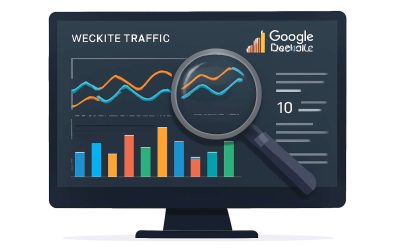Understanding Website Traffic Monitoring
Definition and Purpose – What website traffic monitoring is and why it matters for online success
Imagine your website as a bustling city — every visitor a lively passerby, each navigating streets crafted by your digital architecture. But how can you truly understand the ebb and flow of this urban spectacle? That’s where what is website traffic monitoring becomes a vital compass, illuminating the invisible currents of user behaviour. It’s not merely about numbers; it’s about deciphering the silent stories behind clicks, views, and dwell times, revealing where your digital city thrives and where shadows linger.
At its core, website traffic monitoring is the art of tracking and analysing the movement of visitors on your site. This process offers a window into their journey, providing insights that can shape your strategy and elevate your online presence. It answers questions like: Which pages captivate your audience? How do visitors arrive, and where do they depart? Such understanding fuels smarter decisions, aligning your efforts with the true heartbeat of your digital audience.
- Identify sources of traffic, whether organic, paid, or referral.
- Measure engagement metrics such as bounce rate and session duration.
- Track conversion pathways to optimise your site’s effectiveness.
Key Components – Core elements tracked, such as visitors, page views, and behavior
Understanding what is website traffic monitoring goes beyond mere numbers; it’s about uncovering the hidden stories behind each visit. The core components tracked within this process reveal the intricate dance of user interaction, shedding light on behaviours that shape your online success. Visitors, for instance, are the lifeblood of your digital city—each one representing a potential conversion or a missed opportunity.
Key elements include not only the raw counts of page views but also the nuanced behaviours such as dwell time, bounce rates, and navigation paths. These metrics act as a digital pulse, revealing which parts of your site resonate and which areas need strategic refinement. Tracking these components helps decipher the mystery of visitor engagement, guiding decisions that can dramatically influence your SEO performance.
To simplify the complex, consider these vital elements:
- Number of visitors and returning users
- Page views and unique page visits
- Behaviour flow and exit points
- Engagement metrics like session duration and bounce rate
By paying close attention to these facets, you gain a clearer picture of your website’s health and potential—an essential step in mastering what is website traffic monitoring for optimal SEO impact.
Benefits for Businesses – How monitoring enhances marketing strategies, improves user experience, and boosts conversions
Understanding website traffic monitoring benefits for businesses reveals a tapestry of opportunities that can transform digital presence. When you truly grasp what is website traffic monitoring, you unlock insights that help refine marketing strategies and foster deeper connections with your audience. By tracking visitor behaviour and engagement, businesses can identify which content resonates most, enabling targeted campaigns that speak directly to user interests.
In addition, monitoring website traffic provides a clearer picture of user experience. It highlights pain points and navigational hurdles, allowing for strategic adjustments that make visitors feel valued and understood. This process can lead to increased conversions, as optimised pathways encourage visitors to take meaningful actions.
Many successful enterprises leverage detailed analytics, such as session duration and exit points, to fine-tune their online efforts. As a result, they cultivate a more welcoming digital environment that nurtures loyalty and growth. Truly, understanding what is website traffic monitoring opens the door to sustained success, rooted in empathetic engagement and strategic insight.
Types of Website Traffic Monitoring Tools
Analytics Platforms – Popular tools like Google Analytics, Matomo, and Adobe Analytics
Imagine peering into the heartbeat of your digital domain—this is the essence of understanding what is website traffic monitoring. It’s not merely about numbers; it’s about deciphering the silent stories behind each visitor, each click, each journey through your site’s labyrinth. To truly harness this knowledge, powerful analytics platforms stand as your enchanted companions, translating raw data into illuminating insights.
Popular tools like Google Analytics, Matomo, and Adobe Analytics serve as your navigators in this vast digital landscape. They offer a symphony of features—from tracking visitor behaviour to analysing conversion paths—each one revealing layers of user intent and engagement. For instance, Google Analytics provides a detailed map of how visitors arrive and interact, while Matomo champions privacy-conscious insights. Adobe Analytics, on the other hand, excels in integrating cross-channel data to craft a comprehensive narrative of online presence.
- Ease of integration with existing marketing tools
- Customisable dashboards tailored to your goals
- Real-time data updates for immediate insights
These tools form the backbone of a strategic approach, allowing businesses to elevate their SEO efforts by understanding precisely where their traffic originates and how visitors behave. In the realm of website traffic monitoring, each platform adds a unique brushstroke to your ever-expanding canvas of online success.
Real-Time Monitoring – Live traffic updates and immediate data insights
In the dynamic theatre of the digital realm, where every second counts and each click writes a silent story, real-time monitoring emerges as the vigilant sentinel of your online domain.
It’s the instantaneous pulse that reveals who is visiting your site, from where they come, and what excites or deters their journey. The question of what is website traffic monitoring becomes clearer when you witness this live symphony of activity—visitors dancing through pages, conversions unfolding in the blink of an eye.
Through live traffic updates, businesses gain the power to respond swiftly, optimise user experiences, and adapt marketing strategies on the fly. Tools equipped with real-time data display a colourful mosaic of visitor behaviour, allowing for immediate insights into traffic spikes or drops. This rapid feedback loop is vital for SEO, turning raw numbers into actionable intelligence, and ensuring your site remains a vibrant hub amid the ever-shifting digital landscape.
In essence, real-time monitoring transforms your understanding from a distant observation into an active conversation—an essential element in mastering what is website traffic monitoring for strategic growth and online success.
Custom Tracking Solutions – Tailored tools for specific business needs and KPIs
In the grand orchestration of digital strategy, one size never fits all. Custom tracking solutions emerge as bespoke instruments, meticulously tuned to resonate with your unique business symphony. These tailored tools transcend generic analytics, forging pathways aligned with your specific KPIs and strategic ambitions. Instead of relying solely on off-the-shelf platforms, savvy organisations invest in solutions that capture the nuances of their digital footprint, adapting seamlessly to evolving goals.
Such bespoke tools often incorporate a blend of advanced tracking pixels, behavioural analytics, and specialised widgets, all designed to illuminate the shadows of your website traffic. They offer a granular view—pinpointing exactly which campaigns, content, or user segments drive meaningful engagement. Consider a customised dashboard that consolidates data streams into a single, intuitive interface, enabling rapid decision-making and precise optimisation. This personalised approach transforms the abstract question of what is website traffic monitoring into a strategic weapon, sharpening your focus amid the chaos of the digital marketplace.
- Define your specific KPIs and objectives, ensuring the tracking aligns with your overall marketing vision.
- Develop or commission tools that integrate seamlessly with your existing systems for a unified data view.
- Continuously refine your solutions, adapting to shifts in user behaviour and market trends.
Ultimately, custom tracking solutions are more than just tools—they are your digital compass, guiding your journey through the labyrinth of online engagement with precision and grace. In a landscape where every click counts, knowing what is website traffic monitoring becomes an art form—crafted uniquely for your enterprise’s ascent.
Key Metrics in Website Traffic Monitoring
Visitors and Sessions – Understanding unique visitors and session duration
In the realm of what is website traffic monitoring, deciphering the tales told by visitors becomes paramount. Among the most enchanting metrics are visitors and sessions — the twin pillars that illuminate how audiences engage with your digital domain. Visitors, often called unique visitors, are the travellers who arrive at your site, each counted once within a given timeframe, regardless of how often they return. Meanwhile, sessions represent the journey — the time span from a visitor’s first click to their last before departure.
Understanding these metrics reveals the true heartbeat of your online presence. For instance, a surge in visitors suggests growing interest, while prolonged session durations hint at compelling content or user engagement. This symbiotic dance of visitors and sessions forms the bedrock of what is website traffic monitoring, transforming raw data into a narrative of your website’s vitality and allure.
Traffic Sources – Identifying where visitors come from (organic, direct, referral, paid)
Understanding what is website traffic monitoring unveils the intricate pathways through which visitors traverse your digital sanctuary. Among the many facets of this realm, traffic sources stand out as the guiding stars that illuminate where your audience originates. Are they discovering your site through organic search, drawn by the allure of search engines? Or do they arrive via direct visits, straight from their browser’s address bar? Perhaps they’re coming through referrals from other websites, or even paid campaigns designed to attract attention.
Each source tells a different story—some whisper of organic growth, others sing of strategic investments. To truly grasp the essence of your visitor landscape, categorising these origins becomes essential. You might find it helpful to visualise this with a simple list:
- Organic search
- Direct traffic
- Referral links
- Paid advertising
By deciphering these signals, you gain a richer understanding of your audience’s journey, enabling you to refine your SEO strategies and enhance overall engagement. This is the magic of what is website traffic monitoring — transforming raw data into a symphony of insights that drive your digital success forward.
Behavior Metrics – Pages viewed, bounce rate, and conversion rate
Understanding the nuances of behavior metrics in website traffic monitoring reveals the subtle dance of user engagement. Pages viewed per session serve as a window into how captivating your content truly is—more pages suggest deeper interest, while fewer might signal disinterest or misalignment. The bounce rate, often viewed with trepidation, indicates the percentage of visitors who leave after viewing only one page; a high bounce rate can hint at disconnects between visitor expectations and your site’s offerings. Conversely, a low bounce rate suggests a compelling experience that encourages exploration.
The conversion rate, perhaps the most telling metric, measures the proportion of visitors who complete desired actions—be it signing up, purchasing, or simply engaging with your content. To visualise this data, imagine a simple list:
- Pages viewed
- Bounce rate
- Conversion rate
These figures don’t just reveal behaviour—they unveil the soul of your digital presence, guiding your journey towards optimisation. In the grand tapestry of what is website traffic monitoring, these insights transform raw data into a compelling narrative of user interaction and success.
Device and Location Data – Insights into user devices and geographic distribution
In the intricate ballet of digital presence, understanding what is website traffic monitoring becomes essential to deciphering the silent whispers of your audience. Beyond mere numbers, this realm unveils the story of user devices and their geographic footprints—each data point a brushstroke in the grand canvas of your online influence. Device data, for instance, reveals whether visitors arrive on sleek smartphones, powerful desktops, or tablets—each requiring a nuanced approach to optimise user experience.
Meanwhile, location data offers a panoramic view of your reach—where your visitors hail from, their time zones, and cultural nuances. Visualising this, imagine a world map dotted with vibrant nodes representing your audience—an ordered list of top countries or cities can reveal unexpected hotspots or silent deserts in your digital empire. Such insights not only inform localisation strategies but also deepen your understanding of your audience’s behaviour, making the art of what is website traffic monitoring truly a voyage into the soul of your digital realm.
Implementing Website Traffic Monitoring Strategies
Setting Goals and KPIs – Defining what success looks like for your website
In the shadowy corridors of digital enterprise, clarity emerges only through the dim glow of purpose. To truly grasp what is website traffic monitoring, one must first set the compass—defining what success whispers to your domain’s soul. Setting goals and KPIs transforms abstract data into a blueprint of ambition. It’s about more than numbers; it’s about understanding the elusive dance of visitors, their behaviour, and the unseen pathways they tread.
By establishing precise objectives—perhaps increasing organic traffic by a certain percentage or reducing bounce rates—your website becomes more than a static vessel. It becomes a living entity, pulsating with purpose. To guide this spectral journey, a structured approach such as an ordered list of KPIs can illuminate the way:
- Number of unique visitors
- Session duration
- Conversion rate
- Traffic sources
- Device and geographic data
Such measures forge the boundary between chaos and order, revealing what is website traffic monitoring’s true essence—an unyielding pursuit to decipher the cryptic signals of digital visitors.
Integrating with Marketing Campaigns – Using data to optimize SEO, PPC, and content efforts
Implementing website traffic monitoring strategies is akin to tuning a finely crafted instrument, allowing marketers to harness the full potential of their digital symphony. When integrated seamlessly with marketing campaigns, this approach transforms raw data into actionable insights that can elevate SEO, PPC, and content efforts to new heights. By analysing traffic patterns and user behaviour, businesses can identify which channels deliver the most engaged visitors and adjust their strategies accordingly.
For example, a detailed understanding of traffic sources—whether organic, direct, referral, or paid—can reveal where to focus investment for maximum return. Employing an ordered list like this can clarify the optimisation process:
- Refine keyword targeting based on traffic segments
- Adjust ad spend to priority channels with higher conversion rates
- Personalise content to suit user preferences and device types
This integration of website traffic monitoring with marketing initiatives ensures campaigns are more precise, efficient, and ultimately more impactful. It’s about turning the cryptic signals of digital visitors into a vivid map guiding your growth journey. So, understanding what is website traffic monitoring is not simply about tracking numbers; it’s about unleashing a strategic force that propels your brand’s story through the ever-evolving digital landscape.
Analyzing Data for Improvements – Interpreting analytics to make informed decisions
In the shadowed corridors of the digital realm, understanding what is website traffic monitoring can feel like deciphering a cryptic, ancient script. Behind every click, scroll, and linger lies a hidden story—an intricate dance of user behaviour waiting to be uncovered. By analysing this data, marketers gain a hauntingly clear view of how visitors navigate their virtual labyrinths, revealing which pathways lead to success and which corridors are best left unexplored.
Interpreting analytics isn’t simply about numbers; it’s about awakening a deeper insight into the soul of your website. It involves recognising patterns—such as sudden traffic surges or unexpected bounce rates—that act as spectral signals guiding strategic adjustments. For instance, an unanticipated increase in referral traffic may suggest a powerful alliance or a ghostly echo from an influential source. Understanding these nuances allows for a refined approach to refine keyword targeting, adjust ad spend, and personalise content—turning raw data into an enchanted map of growth. When executed with precision, interpreting this data transforms your website into a living, breathing entity—forever evolving through the dark art of analytics.
Ensuring Privacy and Compliance – Handling user data responsibly and adhering to regulations
Implementing website traffic monitoring strategies demands a delicate balance between technological precision and ethical responsibility. As the digital landscape becomes more intricate, so too must our commitment to handling user data with the utmost respect and care. Ensuring privacy and compliance isn’t merely a legal obligation; it is the foundation of trust that sustains your online presence.
Adherence to regulations such as GDPR and CCPA transforms data collection from a shadowy intrusion into a transparent exchange. Companies must craft clear privacy policies, obtain explicit consent, and anonymise sensitive information whenever possible. This conscientious approach not only safeguards user rights but also enhances your brand’s credibility.
Furthermore, integrating privacy-focused tools—like opt-in cookies and encrypted data transmission—ensures your website remains a sanctuary for visitors. When these strategies are woven into your traffic monitoring framework, they form a resilient shield—allowing you to glean valuable insights without compromising the integrity of user trust. In this dance of data and discretion, respecting privacy is the true magic that empowers sustainable growth.
Challenges and Best Practices
Common Pitfalls – Overlooking data accuracy, data overload, and privacy issues
While the allure of real-time data can be intoxicating, there’s a treacherous undercurrent lurking beneath the surface of what is website traffic monitoring. One common challenge is overlooking data accuracy—believing every click or visit is gospel truth can lead to misguided strategies. As if that weren’t enough, the vast expanse of data can quickly become an overwhelming deluge, causing analysts to drown in information without finding meaningful insights. It’s crucial to remember that not all data is created equal; sloppily collected or unverified information can skew your entire approach.
Moreover, privacy issues are a constant spectre haunting those who dare to scrutinise website visitors’ behaviour. Mishandling user data or neglecting compliance regulations can lead to hefty fines and tarnished reputations. To navigate these pitfalls, it’s wise to adopt best practices such as regularly auditing data sources, prioritising data privacy, and maintaining a streamlined focus on key performance indicators. After all, flawless data is the backbone of meaningful analysis in the realm of what is website traffic monitoring.
Best Practices – Regular monitoring, segmentation, and continuous optimization
Monitoring website traffic is a vital yet intricate endeavour—one that can reveal hidden patterns and unlock new avenues for growth. However, the path is riddled with challenges that demand a strategic approach. Regular monitoring is essential, but it must be paired with segmentation to truly understand different visitor groups and their behaviours. Without this nuanced view, insights risk becoming superficial, leading to misguided decisions.
To navigate this complex landscape, continuous optimisation becomes your best ally. Fine-tuning your tracking parameters and focusing on key performance indicators (KPIs) help maintain clarity amidst the deluge of data. An effective way to ensure this is by employing
- precise data segmentation
- consistent audits of analytics tools
- prioritising privacy compliance
. These best practices act as a compass, guiding you through the fog of raw data and towards actionable intelligence.
Future Trends – AI-powered analytics and advanced tracking methods
As the digital landscape becomes increasingly competitive, understanding what is website traffic monitoring is no longer optional—it’s essential. Yet, as algorithms evolve and user behaviours shift, the challenges of interpreting vast data streams grow more complex. Traditional analytics tools can sometimes drown marketers in a sea of superficial metrics, obscuring the real story behind visitor engagement.
Future trends in website traffic monitoring are pointing towards AI-powered analytics and advanced tracking methods that promise greater accuracy and deeper insights. These innovations can automatically identify patterns, segment audiences with precision, and predict behaviour trends before they materialise. For instance, machine learning algorithms can dynamically adjust KPIs based on emerging data, enabling more agile optimisation.
An intriguing development is the integration of behavioural analytics with real-time data. This fusion allows businesses to respond instantly to visitor actions—an invaluable advantage in today’s fast-paced digital arena. As these technologies mature, they will unlock even richer layers of understanding, transforming raw data into strategic gold!
- Enhanced data segmentation for nuanced visitor insights
- Automated anomaly detection to flag unusual traffic patterns
- Predictive analytics to forecast future website performance
Embracing these emerging trends will ensure that your approach to what is website traffic monitoring remains ahead of the curve, empowering smarter decisions and fostering sustained growth in an ever-evolving digital ecosystem.
Conclusion – Leveraging website traffic data for sustained growth
While understanding what is website traffic monitoring is essential, navigating its challenges is equally crucial for sustained growth. One common obstacle is data overload—sifting through vast streams of raw information can be overwhelming, often leading to superficial insights that don’t truly inform strategic decisions. Additionally, maintaining data accuracy and ensuring privacy compliance are persistent hurdles, especially as regulations tighten worldwide. Without careful attention, these issues can distort your analysis and undermine trust.

Adopting best practices is vital. Regularly reviewing traffic data, leveraging behavioural analytics, and segmenting visitors can illuminate nuanced patterns that raw numbers alone might conceal. For instance, implementing automated anomaly detection can swiftly flag unusual traffic surges or drops—saving time and preventing misguided actions. Moreover, aligning your website traffic monitoring efforts with clear KPIs ensures every metric serves a purpose, transforming data into actionable intelligence.
Ultimately, embracing these strategies helps you navigate the complex landscape of what is website traffic monitoring, turning potential pitfalls into opportunities for smarter decision-making and continuous optimisation.



0 Comments